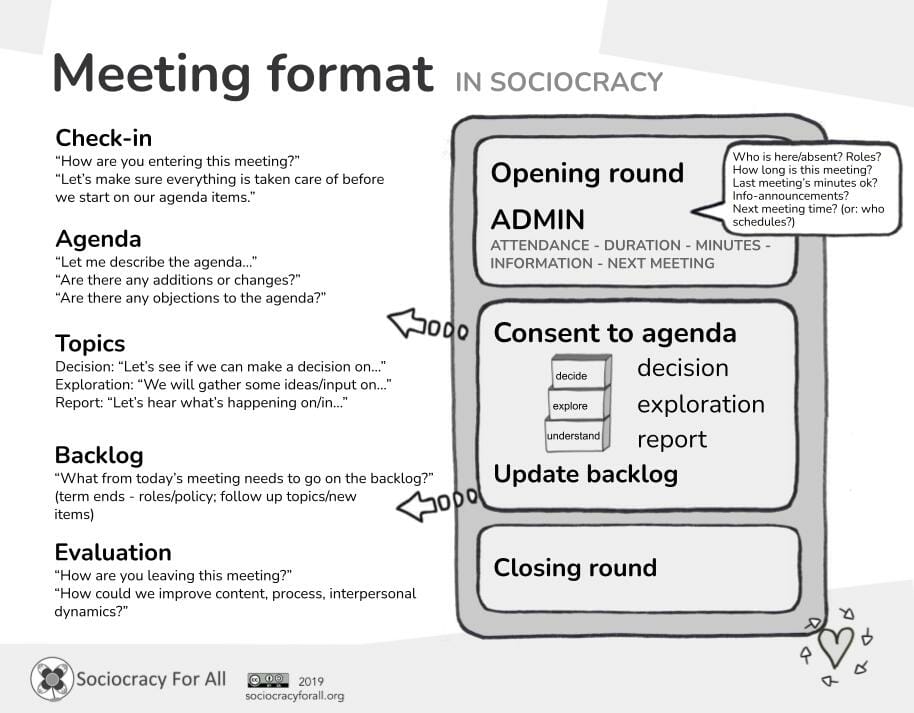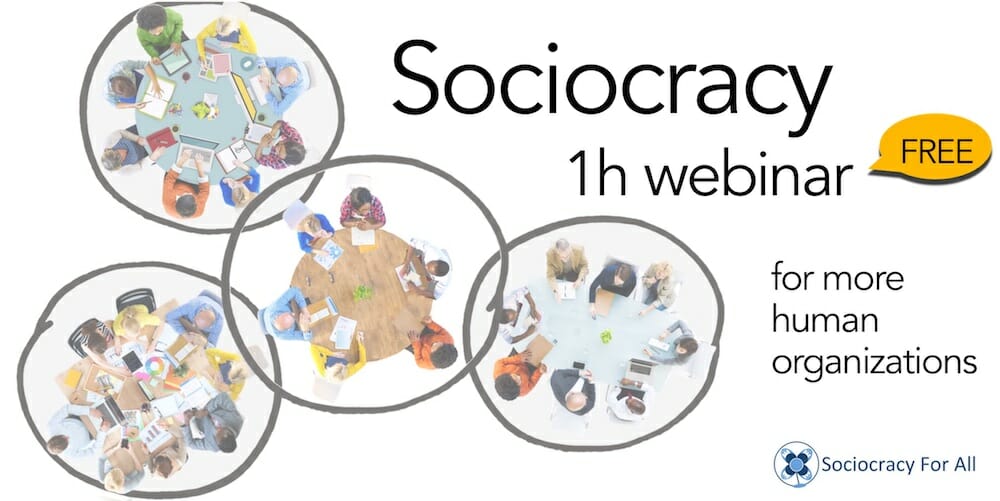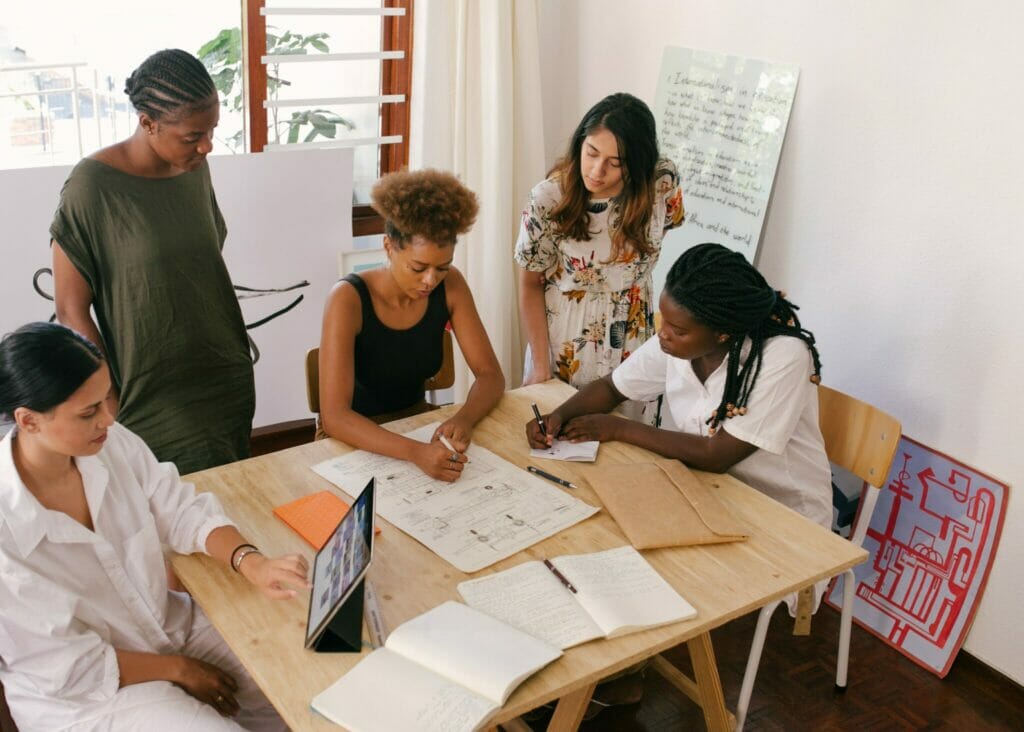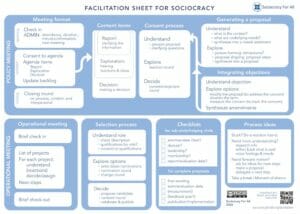Policy meetings or team meetings are held to create clarity for the work done by and in a circle. Depending on the way your meetings are set up, circle meetings can either contain only policy or governance decisions, or it can mix operational and policy decisions. The sociocratic meeting format provides structure to help you do both.
This article will go through the different stages of meetings, as outlined in more detail in the chapter on meeting formats in our book Many Voices, One Song which also has many more examples and more diagrams.
This meeting format is no rocket science at all — but having a solid, somewhat standardized and agreed-upon meeting format helps everyone contribute in the meeting. When the process is clear, we can focus on each other and on our work.
Basic meeting format
Any meeting falls into three phases, each with their own aim:
- Opening: Making sure people & circle are ready for the meeting
- Content: Creating more clarity for the circle’s work.
- Closing: Evaluating the meeting to improve meetings over time.
With that in mind, the sociocratic meeting format considers each phase. See this diagram for an overview; we will touch on each step in this article.

Opening the meeting
Check-in/Opening Round
We start the meeting as human beings. Everyone comes in with a story, a context, an immediate experience previous to the meeting. This might be rush hour in the metro, a spilled coffee, a newborn baby, a divorce, a death in the family, a frustration with another circle, gratitude about spring weather, experiencing pride towards work accomplished, anxiety about an agenda item in the upcoming meeting or just the desire for a third cup of coffee. The more we share, the more we can be three-dimensional human beings. Showing our human side will make it easier to be empathetic, to support each other, be allies to each other.
This is not about making a meeting a therapy group, this is about reminding ourselves that we are human beings. When we have shared whatever affects us in the moment, we are ready to shift our attention to the circle business.

ADMIN
The human beings in the room might be ready for the meeting now but the circle still needs to get ready. We describe this as the ADMIN phase, with each letter in “admin” standing for one piece that needs brief attention. Neither of these steps takes a lot of time (less than a minute total), but each of these item prevents a likely interruption or disruption during or after the meeting.
- Attendance: we make sure our note taker is present, and we take note of who is absent. We will need this information later for building the agenda.
- Duration: Create clarity by checking in on the duration. Otherwise, too many meetings are being scheduled without clarity on the duration of the meeting, and without clarity on whether everyone can stay until the agreed-upon meeting time.
- Minutes: Have last meeting’s minutes been consented to and have they been published in the logbook? Have people who missed last time’s minutes read and understood the minutes? In short: are we all on the same page so we don’t have to circle back to last meeting’s business?
- Information: Is there anything else people want to share? This could be reminding people of an organization-wide event, or a personal announcement. If people have a chance to say it now, they will be more relaxed and focused.
This is only for announcements from outside the circle. Any reports from the domain of the circle belong into the meeting agenda. If any announcement like this is complicated or sparks a discussion, either stop the discussion or, if it is relevant to the circle, make it an agenda item. - Next meeting: Is there a next meeting date? If not, is there a plan on when and how the circle is coming to a next meeting date? Even if there is a standing meeting time, it is worth acknowledging time and date because any regular meeting time might, for example, conflict with national holidays or other events.
If the question of a next meeting date is complicated, then make it an agenda item.
Now the circle is ready and has moved everything out of the way that might distract circle members from the focus on their work. Time for the next step, the content part of the meeting!

The content of the meeting
The content part of the meeting falls into three steps:
- Consent to agenda
- Address topics
- Updating the backlog: assessing the progress of the agenda items
Consent to agenda
We plan the agenda, and — an essential ingredient of sociocracy — the circle consents to the agenda. By adjusting and consenting to the agenda, the circle takes responsibility for the agenda. We all make an effort to stay true to our commitment and it does not solely lie on the facilitator to make the meeting successful.
An agenda will be more effective if it has three parts:
- the list of agenda items and an order in which to address them
- how much time we are allotting to each agenda item (either as shown below — neutral to time zones and with detailed start and beginning which makes it very easy to be accountable, or just the number of minutes allotted)
- what our desired outcome is for each agenda item: report, exploration or decision (see next section)
Example Agenda
| Time | Duration | Topic | Aim |
|---|---|---|---|
| 0:00 | 5 | Check-in | |
| 0:05 | 3 | Attendance: Who is here? Who is facilitating, leading, taking notes? Duration: How long will this meeting be? Can everyone stay the whole length? Minutes: Any comments on the minutes from last meeting? Information: Does Anyone have any important announcements? Next Meeting: Schedule next meeting | |
| 0:08 | 2 | Consent to Agenda | D |
| 0:10 | 5 | Last week’s fundraising event | R |
| 0:20 | 10 | Brainstorming on how to solve crisis | E |
| 0:30 | 5 | Update the backlog | |
| 0:35 | 5 | Check out |
Example of consenting to an agenda
This is what it might sound like to consent to the agenda:

Facilitator: “So, we have an agenda prepared here. Let’s look at it so we all understand what is happening. First we’re going to talk about [agenda item 1] which is a report and will hopefully just take 5 minutes. Then we’ll explore ideas on [agenda item 2] and I think we’ll make a lot of progress if we do that for 10 minutes. [Agenda item 3] is a decision we have to make, and I reserved 20 minutes for that to make sure there is enough time. Is there any question about this agenda? (pause) Seeing none. Are there any objections to this agenda?”
Circle Member: “I object since Margret said she has to leave early, she’d miss item 3 which makes it hard to make a decision. Wouldn’t it be better to switch item 2 and 3 to make sure we’ll all be here?”
Facilitator: “That makes a lot of sense, thank you. Ok, so re-stating my proposal here, I would like to talk about [agenda item 1], then [agenda item 3], then we’ll bounce ideas about [agenda item 2]. Any other objections? (pause) Hearing none, that means we have consent and are ready to go!”
Agenda items
The circle is now ready to talk about all the agenda items.
- Reports will be a sharing of relevant information.
- In explorations, we generate ideas in relationship to an issue or a prompt.
- Decisions will approve proposals that guide the circle’s work, or elections.
In sociocratic meetings, policy decisions are made by consent, which means that a decision is made when no one in the circle has an objection. Objections are a way of directing our attention to an aspect of the proposal that still needs improvement until it is “good enough for now”. Whenever possible, a circle tries to get to a point where a policy can be put into place — even if it just for a limited time — so new information can be gathered and evaluated when the policy gets reviewed.
For very disciplined circles, we recommend reading back the minutes after every agenda item is completed, before moving on to the next agenda item.
Changes in the agenda — for example going for a decision instead of just exploration, or postponing an agenda item as well as going over time significantly — require the circle’s consent. That way, we are intentional about how we spend our time together while still being flexible.
Update backlog
After going through all agenda items, it helps to look through the agenda as planned again and to write in the backlog (the running list of topics to talk about in the future) to take note of how future agenda items might continue or build on the progress made today.

For example, if a role has been created today, are we going to select someone into that role next time? If we had to postpone a topic today, when are we going to talk about it? If we created policy today, let’s put the review date for that policy on the backlog or in the calendar. Agenda planning for the next meeting(s) will be much easier if you take those three minutes during the meeting to gather that information while it is still fresh. Some groups also choose to do a review of all action items at that point. Below is an example of what this phase might sound like.
Example of updating the backlog
Facilitator: “Ok, so we consented to postpone [agenda item 2] so that should be on the agenda for next time. I will also note down the date for the evaluation of today’s decision. We did not talk yet about how we are going to make sure everyone knows about this policy change. So, let me put that on the backlog as well. Anything else someone is aware of for agenda items?”
Circle Member: “Yes, we had asked for Parveen to report again next time like she did today.”Facilitator: “You’re right, let’s write that down as well. Anything else? (pause) Hearing none, so I think we’re ready for our check-out.”
Closing the meeting
Check-out round
We close the meeting with a meeting evaluation where each member, in a round, highlights their observations and reflections on the meeting.

Interested in meeting facilitation?
During that check-out, circle members can reflect on anything that seems relevant to them. Typically, you can give useful feedback on:
- interpersonal dynamics (gratitude, tension, style of communication, sense of connection etc.)
- the content of the work (how much got done, how much clarity was created, was a difficult topic finally dealt with etc.) and
- the process of the meeting (did the facilitation feel firm enough/too rigid, was the meeting time kept, did the choice of agenda items seem relevant, was there crosstalk during rounds etc.)
Governance strives to create as much clarity as possible in as little time as possible. Thus, this meeting format is designed to be simple and thorough. Of course, any meeting can be done with only some of the steps — however, any step skipped means higher risk for confusion. In our experience, a clear meeting structure makes the meeting faster and smooth — which frees up our minds for more interpersonal connection.



Leave a Reply
You must be logged in to post a comment.